Zhaohu Xing
Touchstone Benchmark: Are We on the Right Way for Evaluating AI Algorithms for Medical Segmentation?
Nov 06, 2024



Abstract:How can we test AI performance? This question seems trivial, but it isn't. Standard benchmarks often have problems such as in-distribution and small-size test sets, oversimplified metrics, unfair comparisons, and short-term outcome pressure. As a consequence, good performance on standard benchmarks does not guarantee success in real-world scenarios. To address these problems, we present Touchstone, a large-scale collaborative segmentation benchmark of 9 types of abdominal organs. This benchmark is based on 5,195 training CT scans from 76 hospitals around the world and 5,903 testing CT scans from 11 additional hospitals. This diverse test set enhances the statistical significance of benchmark results and rigorously evaluates AI algorithms across various out-of-distribution scenarios. We invited 14 inventors of 19 AI algorithms to train their algorithms, while our team, as a third party, independently evaluated these algorithms on three test sets. In addition, we also evaluated pre-existing AI frameworks--which, differing from algorithms, are more flexible and can support different algorithms--including MONAI from NVIDIA, nnU-Net from DKFZ, and numerous other open-source frameworks. We are committed to expanding this benchmark to encourage more innovation of AI algorithms for the medical domain.
Infinity-MM: Scaling Multimodal Performance with Large-Scale and High-Quality Instruction Data
Oct 24, 2024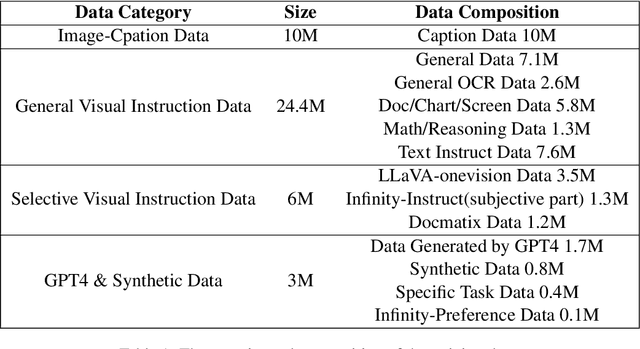
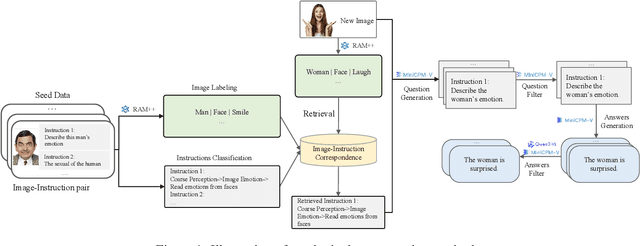
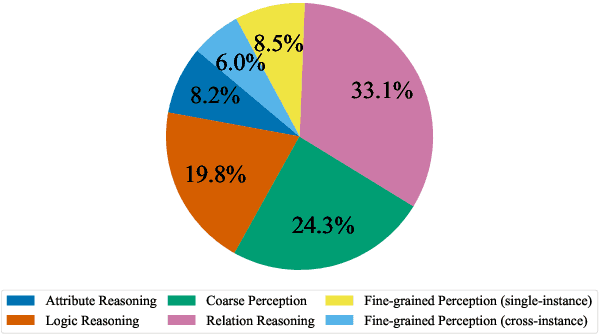

Abstract:Vision-Language Models (VLMs) have recently made significant progress, but the limited scale and quality of open-source instruction data hinder their performance compared to closed-source models. In this work, we address this limitation by introducing Infinity-MM, a large-scale multimodal instruction dataset with 40 million samples, enhanced through rigorous quality filtering and deduplication. We also propose a synthetic instruction generation method based on open-source VLMs, using detailed image annotations and diverse question generation. Using this data, we trained a 2-billion-parameter VLM, Aquila-VL-2B, achieving state-of-the-art (SOTA) performance for models of similar scale. This demonstrates that expanding instruction data and generating synthetic data can significantly improve the performance of open-source models.
Non-Invasive to Invasive: Enhancing FFA Synthesis from CFP with a Benchmark Dataset and a Novel Network
Oct 19, 2024Abstract:Fundus imaging is a pivotal tool in ophthalmology, and different imaging modalities are characterized by their specific advantages. For example, Fundus Fluorescein Angiography (FFA) uniquely provides detailed insights into retinal vascular dynamics and pathology, surpassing Color Fundus Photographs (CFP) in detecting microvascular abnormalities and perfusion status. However, the conventional invasive FFA involves discomfort and risks due to fluorescein dye injection, and it is meaningful but challenging to synthesize FFA images from non-invasive CFP. Previous studies primarily focused on FFA synthesis in a single disease category. In this work, we explore FFA synthesis in multiple diseases by devising a Diffusion-guided generative adversarial network, which introduces an adaptive and dynamic diffusion forward process into the discriminator and adds a category-aware representation enhancer. Moreover, to facilitate this research, we collect the first multi-disease CFP and FFA paired dataset, named the Multi-disease Paired Ocular Synthesis (MPOS) dataset, with four different fundus diseases. Experimental results show that our FFA synthesis network can generate better FFA images compared to state-of-the-art methods. Furthermore, we introduce a paired-modal diagnostic network to validate the effectiveness of synthetic FFA images in the diagnosis of multiple fundus diseases, and the results show that our synthesized FFA images with the real CFP images have higher diagnosis accuracy than that of the compared FFA synthesizing methods. Our research bridges the gap between non-invasive imaging and FFA, thereby offering promising prospects to enhance ophthalmic diagnosis and patient care, with a focus on reducing harm to patients through non-invasive procedures. Our dataset and code will be released to support further research in this field (https://github.com/whq-xxh/FFA-Synthesis).
Cross-conditioned Diffusion Model for Medical Image to Image Translation
Sep 13, 2024Abstract:Multi-modal magnetic resonance imaging (MRI) provides rich, complementary information for analyzing diseases. However, the practical challenges of acquiring multiple MRI modalities, such as cost, scan time, and safety considerations, often result in incomplete datasets. This affects both the quality of diagnosis and the performance of deep learning models trained on such data. Recent advancements in generative adversarial networks (GANs) and denoising diffusion models have shown promise in natural and medical image-to-image translation tasks. However, the complexity of training GANs and the computational expense associated with diffusion models hinder their development and application in this task. To address these issues, we introduce a Cross-conditioned Diffusion Model (CDM) for medical image-to-image translation. The core idea of CDM is to use the distribution of target modalities as guidance to improve synthesis quality while achieving higher generation efficiency compared to conventional diffusion models. First, we propose a Modality-specific Representation Model (MRM) to model the distribution of target modalities. Then, we design a Modality-decoupled Diffusion Network (MDN) to efficiently and effectively learn the distribution from MRM. Finally, a Cross-conditioned UNet (C-UNet) with a Condition Embedding module is designed to synthesize the target modalities with the source modalities as input and the target distribution for guidance. Extensive experiments conducted on the BraTS2023 and UPenn-GBM benchmark datasets demonstrate the superiority of our method.
Diff-VPS: Video Polyp Segmentation via a Multi-task Diffusion Network with Adversarial Temporal Reasoning
Sep 11, 2024Abstract:Diffusion Probabilistic Models have recently attracted significant attention in the community of computer vision due to their outstanding performance. However, while a substantial amount of diffusion-based research has focused on generative tasks, no work introduces diffusion models to advance the results of polyp segmentation in videos, which is frequently challenged by polyps' high camouflage and redundant temporal cues.In this paper, we present a novel diffusion-based network for video polyp segmentation task, dubbed as Diff-VPS. We incorporate multi-task supervision into diffusion models to promote the discrimination of diffusion models on pixel-by-pixel segmentation. This integrates the contextual high-level information achieved by the joint classification and detection tasks. To explore the temporal dependency, Temporal Reasoning Module (TRM) is devised via reasoning and reconstructing the target frame from the previous frames. We further equip TRM with a generative adversarial self-supervised strategy to produce more realistic frames and thus capture better dynamic cues. Extensive experiments are conducted on SUN-SEG, and the results indicate that our proposed Diff-VPS significantly achieves state-of-the-art performance. Code is available at https://github.com/lydia-yllu/Diff-VPS.
Timeline and Boundary Guided Diffusion Network for Video Shadow Detection
Aug 21, 2024Abstract:Video Shadow Detection (VSD) aims to detect the shadow masks with frame sequence. Existing works suffer from inefficient temporal learning. Moreover, few works address the VSD problem by considering the characteristic (i.e., boundary) of shadow. Motivated by this, we propose a Timeline and Boundary Guided Diffusion (TBGDiff) network for VSD where we take account of the past-future temporal guidance and boundary information jointly. In detail, we design a Dual Scale Aggregation (DSA) module for better temporal understanding by rethinking the affinity of the long-term and short-term frames for the clipped video. Next, we introduce Shadow Boundary Aware Attention (SBAA) to utilize the edge contexts for capturing the characteristics of shadows. Moreover, we are the first to introduce the Diffusion model for VSD in which we explore a Space-Time Encoded Embedding (STEE) to inject the temporal guidance for Diffusion to conduct shadow detection. Benefiting from these designs, our model can not only capture the temporal information but also the shadow property. Extensive experiments show that the performance of our approach overtakes the state-of-the-art methods, verifying the effectiveness of our components. We release the codes, weights, and results at \url{https://github.com/haipengzhou856/TBGDiff}.
AGLLDiff: Guiding Diffusion Models Towards Unsupervised Training-free Real-world Low-light Image Enhancement
Jul 23, 2024



Abstract:Existing low-light image enhancement (LIE) methods have achieved noteworthy success in solving synthetic distortions, yet they often fall short in practical applications. The limitations arise from two inherent challenges in real-world LIE: 1) the collection of distorted/clean image pairs is often impractical and sometimes even unavailable, and 2) accurately modeling complex degradations presents a non-trivial problem. To overcome them, we propose the Attribute Guidance Diffusion framework (AGLLDiff), a training-free method for effective real-world LIE. Instead of specifically defining the degradation process, AGLLDiff shifts the paradigm and models the desired attributes, such as image exposure, structure and color of normal-light images. These attributes are readily available and impose no assumptions about the degradation process, which guides the diffusion sampling process to a reliable high-quality solution space. Extensive experiments demonstrate that our approach outperforms the current leading unsupervised LIE methods across benchmarks in terms of distortion-based and perceptual-based metrics, and it performs well even in sophisticated wild degradation.
Vivim: a Video Vision Mamba for Medical Video Object Segmentation
Feb 07, 2024Abstract:Traditional convolutional neural networks have a limited receptive field while transformer-based networks are mediocre in constructing long-term dependency from the perspective of computational complexity. Such the bottleneck poses a significant challenge when processing long video sequences in video analysis tasks. Very recently, the state space models (SSMs) with efficient hardware-aware designs, famous by Mamba, have exhibited impressive achievements in long sequence modeling, which facilitates the development of deep neural networks on many vision tasks. To better capture available cues in video frames, this paper presents a generic Video Vision Mamba-based framework for medical video object segmentation tasks, named Vivim. Our Vivim can effectively compress the long-term spatiotemporal representation into sequences at varying scales by our designed Temporal Mamba Block. Compared to existing video-level Transformer-based methods, our model maintains excellent segmentation results with better speed performance. Extensive experiments on breast lesion segmentation in ultrasound videos and polyp segmentation in colonoscopy videos demonstrate the effectiveness and efficiency of our Vivim. The code is available at: https://github.com/scott-yjyang/Vivim.
SegMamba: Long-range Sequential Modeling Mamba For 3D Medical Image Segmentation
Jan 25, 2024

Abstract:The Transformer architecture has shown a remarkable ability in modeling global relationships. However, it poses a significant computational challenge when processing high-dimensional medical images. This hinders its development and widespread adoption in this task. Mamba, as a State Space Model (SSM), recently emerged as a notable manner for long-range dependencies in sequential modeling, excelling in natural language processing filed with its remarkable memory efficiency and computational speed. Inspired by its success, we introduce SegMamba, a novel 3D medical image \textbf{Seg}mentation \textbf{Mamba} model, designed to effectively capture long-range dependencies within whole volume features at every scale. Our SegMamba, in contrast to Transformer-based methods, excels in whole volume feature modeling from a state space model standpoint, maintaining superior processing speed, even with volume features at a resolution of {$64\times 64\times 64$}. Comprehensive experiments on the BraTS2023 dataset demonstrate the effectiveness and efficiency of our SegMamba. The code for SegMamba is available at: https://github.com/ge-xing/SegMamba
Hunting imaging biomarkers in pulmonary fibrosis: Benchmarks of the AIIB23 challenge
Dec 21, 2023
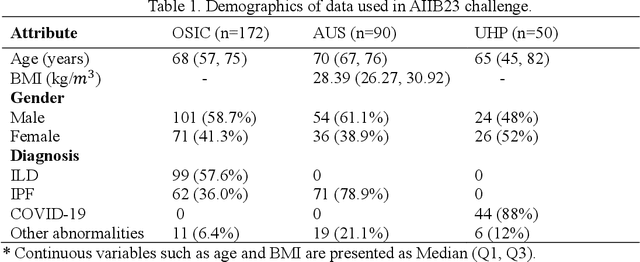
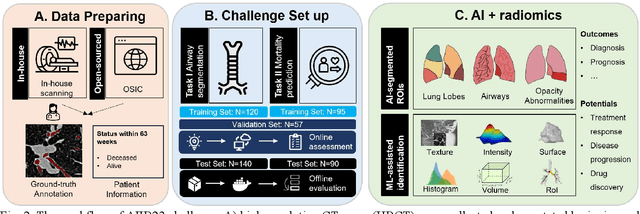
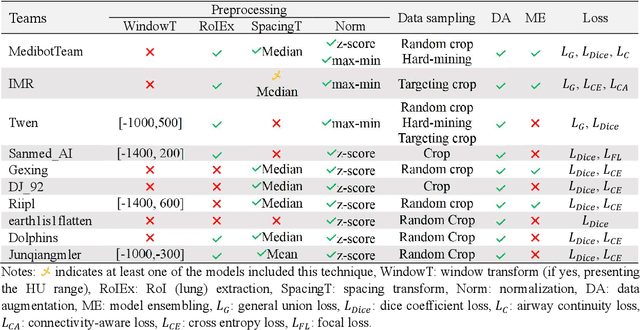
Abstract:Airway-related quantitative imaging biomarkers are crucial for examination, diagnosis, and prognosis in pulmonary diseases. However, the manual delineation of airway trees remains prohibitively time-consuming. While significant efforts have been made towards enhancing airway modelling, current public-available datasets concentrate on lung diseases with moderate morphological variations. The intricate honeycombing patterns present in the lung tissues of fibrotic lung disease patients exacerbate the challenges, often leading to various prediction errors. To address this issue, the 'Airway-Informed Quantitative CT Imaging Biomarker for Fibrotic Lung Disease 2023' (AIIB23) competition was organized in conjunction with the official 2023 International Conference on Medical Image Computing and Computer Assisted Intervention (MICCAI). The airway structures were meticulously annotated by three experienced radiologists. Competitors were encouraged to develop automatic airway segmentation models with high robustness and generalization abilities, followed by exploring the most correlated QIB of mortality prediction. A training set of 120 high-resolution computerised tomography (HRCT) scans were publicly released with expert annotations and mortality status. The online validation set incorporated 52 HRCT scans from patients with fibrotic lung disease and the offline test set included 140 cases from fibrosis and COVID-19 patients. The results have shown that the capacity of extracting airway trees from patients with fibrotic lung disease could be enhanced by introducing voxel-wise weighted general union loss and continuity loss. In addition to the competitive image biomarkers for prognosis, a strong airway-derived biomarker (Hazard ratio>1.5, p<0.0001) was revealed for survival prognostication compared with existing clinical measurements, clinician assessment and AI-based biomarkers.
 Add to Chrome
Add to Chrome Add to Firefox
Add to Firefox Add to Edge
Add to Edge